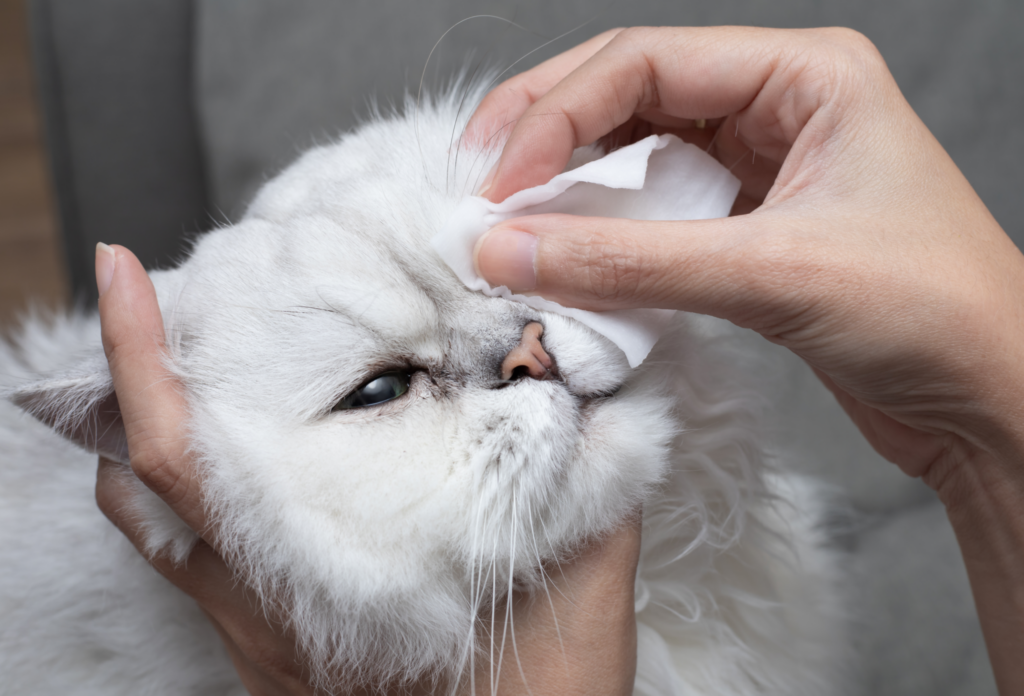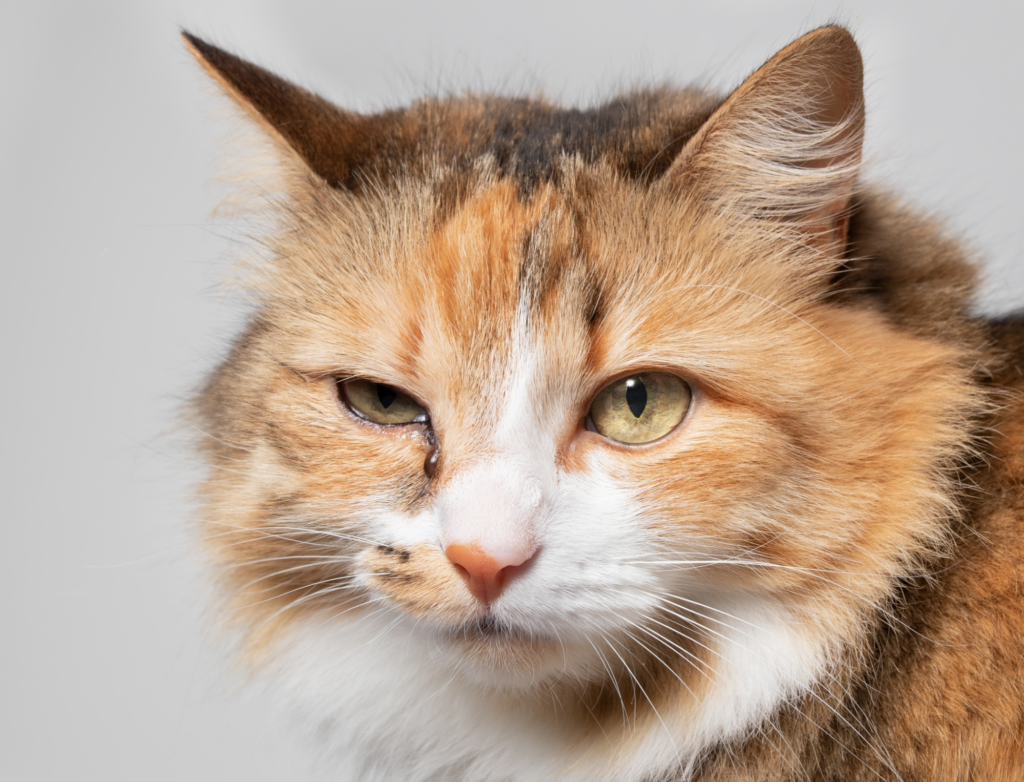Key Points
- Symptoms of cat eye infections include redness, puffiness, and discharge in the eyes.
- Cat eye infections can be caused by allergies, pink eye, and feline herpes virus.
- If you think your cat has an eye infection, reach out to your primary vet for guidance.
Did you know that cats show love with their eyes? Slow blinking is a classic feline display of affection, and cats are famous for their bewitching eyes. And that’s why one of the worst feelings as a cat parent is seeing your cat suddenly squinting, blinking excessively, or pawing at their eyes — and not knowing what’s wrong.
Feline eye infections are very common, ranging from mild irritations to more serious underlying health conditions. Knowing the most common causes and symptoms for cat eye infections can help you nip them in the bud and keep your cat’s eyes sparkling.
What are the signs of a cat eye infection?
If your kitty is displaying one or more of these symptoms, they could be suffering from an eye infection:
- Redness
- Puffiness of one or both eyes
- Watery eyes
- Discharge
- Cloudiness
- A prominent nictitating membrane (aka the third eyelid)
Early detection and appropriate cat eye infection treatment can prevent more serious complications down the line.
Eye infections in stray kittens
Eye infections are also extremely common in stray kittens and cats, and this condition can lead to partial or full blindness and even death. Stray kittens living in unclean environments, and without any humans to care for them, are most prone to infections. If you’re a cat lover (and if you’re reading this, we know you are), it’s natural to want to rescue these poor kitties.
Before taking it upon yourself to care for a stray kitten, be honest about whether you can truly look after them, meet their challenging health needs, and find them a permanent home. Very young kittens may also be too young to survive without their mother, and so removing them from her care could do more harm than good.
At-home tests to assess your cat’s eye health
Your domestic cat relies on you to identify eye problems early and get them the care they need. Here are some simple at-home tests you can conduct to assess your cat’s eye health and detect potential problems early on:
Menace response
The menace response test assesses your cat’s vision and reflexes. First, cover only one of your cat’s eyes, and make a threatening gesture towards the uncovered eye. A healthy cat with good vision should blink or turn their head away in response to the “threat.”
Dazzle reflex
This test checks how your cat’s pupils react to light. In a dim room, quickly shine a light into your cat’s eye. If their pupils constrict rapidly, it means their eyes are reacting as they should. This is mainly used for testing the subcortical reflex and making sure the eye and the brain are communicating correctly.
Cotton ball test
If you notice your cat isn’t reacting to toys or movements like they used to, you can try this simple test. Drop a cotton ball near your cat’s face to see if they react. A cat with normal vision will usually follow the cotton ball with their eyes as it falls.
Palpebral reflex
The palpebral reflex checks the nerves and muscles that control your cat’s blinking. Gently touch the medial canthus (the inner corner) of your cat’s eye with your finger. Normally, they will blink in response to your touch.
Remember, these at-home tests are just a starting point. If cat eye infection symptoms persist or if your gut tells you something is wrong, it’s always best to consult your vet for a professional eye exam.
Common causes of cat eye infections

1. Allergies
Just like you, your cat can experience those sniffles, sneezes, and itchy eyes from allergies. Cat allergies can be caused by many different culprits, including:
- Fleas
- Pollen
- Chemicals
- Smoke
- Shampoo
- Ear mites and other parasites
- Certain foods
It takes a vet to provide an accurate diagnosis. They’ll use a combination of tests to determine the cause of your cat’s discomfort. Skin tests and cultures help rule out other skin conditions that can mimic allergies, such as bacterial or fungal infections. Allergen tests can identify specific allergens that are triggering the allergic reaction.
Symptoms:
- Watery or runny eyes or nose
- Excessive itching or scratching
- Sudden snoring due to inflammation of the throat
- Sneezing
Treatment:
- Identify and avoid the allergen.
- Apply eye drops or ointments to decrease inflammation.
- Manage symptoms with Antihistamines, steroids, and immunosuppressants
- Try immunotherapy.
- Adjust your cat’s lifestyle.
2. Trauma
Is your cat a bit of a daredevil, leaping from tall heights and sparring with the neighborhood cat? While their athleticism is impressive, sometimes those adventures can cause eye-related injuries, including eye infections.
Trauma or damage to the cornea can cause pain, impaired vision, and even blindness. Watch out for signs of blunt trauma, scratches from fighting, and foreign objects in the eye.
Symptoms:
- Squinting, excessive blinking, and pawing at their eye
- Red and inflamed eye
- Excessive tearing
- Discharge from the eyes
- Visible lesions
Treatment:
- Find the underlying problem.
- Apply prescription antibiotic eye drops or ointment.
- Relieve pain and discomfort with oral or injectable pain medication.
- Consider surgery if necessary.

3. Conjunctivitis
Are your cat’s eyes looking red, puffy, and irritated? Then they might have conjunctivitis, also called pink eye. This is an inflammation of the conjunctiva, which is all the tissue around the eye that is normally pink. In cats, you shouldn’t see the conjunctiva unless there is a problem with it.
A blood test can determine if it’s caused by an underlying systemic disease or infection that requires specific treatment.
Luckily, whether the infectious agent is bacterial, viral, or fungi-based, a quick visit to the vet for treatment can clear it up.
Symptoms:
- Whites of the eyes are red and possibly swollen
- Frequent blinking, squinting, or rubbing of the eyes
- Eye discharge that is white, yellow, or green
- Third eyelid covers part of the eye
- Excessive tearing
Treatment:
- Apply prescribed eye drops or ointments to reduce inflammation.
- Remove foreign bodies (such as corneal ulcers) with surgery.
Use prescribed oral antibiotics or anti-viral medications if there is an infection.
4. Epiphora
If your cat’s eyes look like they’ve been crying after a sad movie, they might have epiphora. This common eye condition in cats causes excessive tearing that overflows from the eye instead of draining properly.
This happens because a cat’s tear ducts are blocked from inflammation, infection, or congenital abnormalities. Epiphora can be a sign of something more serious, so don’t hesitate to contact your vet for an accurate diagnosis.
Symptoms:
- Excessive tears
- Wet fur around the eyes
- Tear stains
- Irritated skin
- Unpleasant odor (if caused by a bacterial infection)
Treatment:
- Determine if there is an underlying cause, like corneal ulcers or conjunctivitis.
- Flush your cat’s tear ducts to unblock them (your vet will handle this one).
- Fight off infections with antibiotics.
- Clean your cat’s eyes regularly to prevent irritation and staining.
5. Feline Herpesvirus (FHV-1)
Most cats have at one time or another been exposed to Feline Herpesvirus, which can also cause eye infections in cats. Some cats will show symptoms of the virus, while others will be carriers and show no symptoms because the virus is dormant in their systems.
However, the virus can activate at any time, especially when a cat is stressed. Unfortunately, there’s no cure. There’s no cure for FHV-1, but with the right management strategies, you can help your cat feel more comfortable and minimize flare-ups.
Symptoms
- Upper respiratory symptoms such as coughing, runny nose, or sneezing
- Conjunctivitis
- Corneal ulcerations
Treatment:
- Apply eye drops or a topical treatment to ease symptoms and heal infections.
- Use oral antibiotics or antiviral medications to treat an upper respiratory infection.
- Reduce your cat’s stress by providing safe spaces and respecting their boundaries.
Consider L-lysine vitamin supplements to help minimize virus flare-ups.
6. Feline upper respiratory infection
Feline upper respiratory infections (URIs) are like the common cat cold. It’s especially common in kittens and multi-cat households, where germs spread easily.
One of the main causes is Feline calicivirus, but other viruses and bacteria can also play a role. These infections affect your cat’s nose, throat, and eyes. Generally, it’s just a case of the sniffles and can be managed with rest and TLC.
If it becomes more serious, it can cause conjunctivitis or inflammation of the membranes that line the eyelids.
Symptoms:
- Sneezing
- Nasal discharge
- Congestion
- Watery eyes
- Lethargy and loss of appetite (aka a grumpy cat)
Treatment:
- Make sure your cat is properly hydrated.
- Provide a comfortable, private place for your cat to rest.
- Use a prescribed appetite stimulant or tempt them with yummy treats.
7. Blepharitis

Blepharitis is an inflammation and infection of the eyelids. It can be caused by allergic reactions (like a flea bite) tumors, trauma to the eyelid, and other conditions like diabetes. Your cat’s own hair can also cause Blepharitis if it irritates their eyes.
All cats can get infected, but it’s more common in flat-faced cats like Persians and Himalayans because their anatomy can cause eyelid abnormalities.
For example, imagine your eyelashes constantly brushing against your eyeball — that’s what it can be like for flat-faced cats with entropion or ectropion. This constant irritation can easily lead to inflammation and blepharitis.
Symptoms:
- Swelling of the eyelids
- Rubbing or scratching at the eyes
- Dry or crusty areas around the eyes and discharge
- Leathery or bare areas around the eyes
Treatment:
- Clean the area around the eyes with cotton balls wet with warm water.
- Apply warm compresses to the area to help soothe the eyes.
- Get an Elizabethan collar (Blepharitis can be very itchy) to protect the eyes during the healing process.
- Apply prescribed topical ointments and eye drops to treat inflammation or infection.
- Use oral antibiotics for bacterial infections.
Seeing eye to eye with your kitty
Eye infections in cats are more common than you might think, but they can sometimes signal deeper health conditions beneath the surface. If you notice any changes in your cat’s eyes or if they seem to get recurring eye infections, don’t hesitate to contact your vet.
With a little knowledge and proactive care, you can help your cat maintain healthy eyes and clear vision for a lifetime. Take that proactive care one step further and learn how a Pumpkin cat insurance plan can help you afford the best in care for many future accidents and illnesses.
FAQs
- https://journals.sagepub.com/doi/10.1177/1098612X16660444?icid=int.sj-full-text.similar-articles
- https://www.vet.cornell.edu/departments-centers-and-institutes/cornell-feline-health-center/health-information/feline-health-topics/conjunctivitis
- https://vcahospitals.com/know-your-pet/eye-discharge-or-epiphora-in-cats
- https://vcahospitals.com/know-your-pet/lysine
- https://www.vet.cornell.edu/departments-centers-and-institutes/baker-institute/research-baker-institute/feline-calicivirus
- https://www.eyecareforanimals.com/conditions/blepharitis/
- https://www.preventivevet.com/cats/your-cat-in-a-cone-collar-desensitization
- https://vcahospitals.com/know-your-pet/conjunctivitis-in-cats




